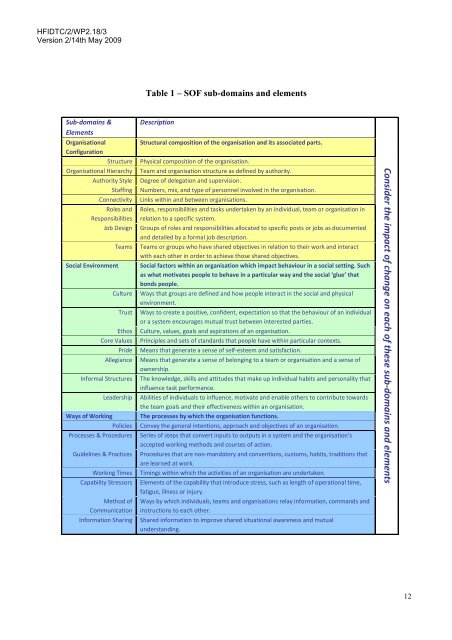Developing the HFI Social & Organisational Domain: Final Report
Developing the HFI Social & Organisational Domain: Final Report
Developing the HFI Social & Organisational Domain: Final Report
You also want an ePaper? Increase the reach of your titles
YUMPU automatically turns print PDFs into web optimized ePapers that Google loves.
<strong>HFI</strong>DTC/2/WP2.18/3Version 2/14th May 2009Table 1 – SOF sub-domains and elementsSub‐domains &Elements<strong>Organisational</strong>ConfigurationStructure<strong>Organisational</strong> HierarchyAuthority StyleStaffingConnectivityRoles andResponsibilitiesJob Design<strong>Social</strong> EnvironmentTeamsCultureTrustEthosCore ValuesPrideAllegianceInformal StructuresWays of WorkingLeadershipPoliciesProcesses & ProceduresGuidelines & PracticesWorking TimesCapability StressorsMethod ofCommunicationInformation SharingDescriptionStructural composition of <strong>the</strong> organisation and its associated parts.Physical composition of <strong>the</strong> organisation.Team and organisation structure as defined by authority.Degree of delegation and supervision.Numbers, mix, and type of personnel involved in <strong>the</strong> organisation.Links within and between organisations.Roles, responsibilities and tasks undertaken by an individual, team or organisation inrelation to a specific system.Groups of roles and responsibilities allocated to specific posts or jobs as documentedand detailed by a formal job description.Teams or groups who have shared objectives in relation to <strong>the</strong>ir work and interactwith each o<strong>the</strong>r in order to achieve those shared objectives.<strong>Social</strong> factors within an organisation which impact behaviour in a social setting. Suchas what motivates people to behave in a particular way and <strong>the</strong> social ‘glue’ thatbonds people.Ways that groups are defined and how people interact in <strong>the</strong> social and physicalenvironment.Ways to create a positive, confident, expectation so that <strong>the</strong> behaviour of an individualor a system encourages mutual trust between interested parties.Culture, values, goals and aspirations of an organisation.Principles and sets of standards that people have within particular contexts.Means that generate a sense of self‐esteem and satisfaction.Means that generate a sense of belonging to a team or organisation and a sense ofownership.The knowledge, skills and attitudes that make up individual habits and personality thatinfluence task performance.Abilities of individuals to influence, motivate and enable o<strong>the</strong>rs to contribute towards<strong>the</strong> team goals and <strong>the</strong>ir effectiveness within an organisation.The processes by which <strong>the</strong> organisation functions.Convey <strong>the</strong> general intentions, approach and objectives of an organisation.Series of steps that convert inputs to outputs in a system and <strong>the</strong> organisation’saccepted working methods and courses of action.Procedures that are non‐mandatory and conventions, customs, habits, traditions thatare learned at work.Timings within which <strong>the</strong> activities of an organisation are undertaken.Elements of <strong>the</strong> capability that introduce stress, such as length of operational time,fatigue, illness or injury.Ways by which individuals, teams and organisations relay information, commands andinstructions to each o<strong>the</strong>r.Shared information to improve shared situational awareness and mutualunderstanding.Consider <strong>the</strong> impact of change on each of <strong>the</strong>se sub‐domains and elements12
















